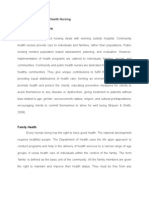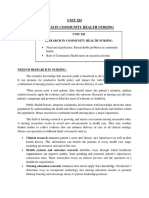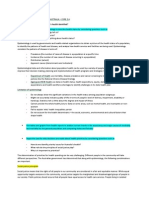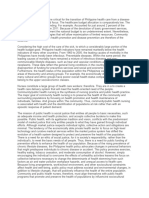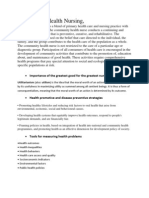0 ratings0% found this document useful (0 votes)
18 viewsPublic Health
Public Health
Uploaded by
Nimra JamilThis document discusses public health services for a diverse urban population of 50,000 people. It identifies key health needs such as obesity, diabetes, and hypertension. Lifestyle factors like poor diet, inactivity, smoking, and drinking impact health outcomes. Public health services aim to meet community needs through primary care, screenings, education, and programs tailored to local demographics and policies. Nursing associates play an important role in prevention, education, care coordination, and advocating for patients and community health.
Copyright:
© All Rights Reserved
Available Formats
Download as DOCX, PDF, TXT or read online from Scribd
Public Health
Public Health
Uploaded by
Nimra Jamil0 ratings0% found this document useful (0 votes)
18 views13 pagesThis document discusses public health services for a diverse urban population of 50,000 people. It identifies key health needs such as obesity, diabetes, and hypertension. Lifestyle factors like poor diet, inactivity, smoking, and drinking impact health outcomes. Public health services aim to meet community needs through primary care, screenings, education, and programs tailored to local demographics and policies. Nursing associates play an important role in prevention, education, care coordination, and advocating for patients and community health.
Copyright
© © All Rights Reserved
Available Formats
DOCX, PDF, TXT or read online from Scribd
Share this document
Did you find this document useful?
Is this content inappropriate?
This document discusses public health services for a diverse urban population of 50,000 people. It identifies key health needs such as obesity, diabetes, and hypertension. Lifestyle factors like poor diet, inactivity, smoking, and drinking impact health outcomes. Public health services aim to meet community needs through primary care, screenings, education, and programs tailored to local demographics and policies. Nursing associates play an important role in prevention, education, care coordination, and advocating for patients and community health.
Copyright:
© All Rights Reserved
Available Formats
Download as DOCX, PDF, TXT or read online from Scribd
Download as docx, pdf, or txt
0 ratings0% found this document useful (0 votes)
18 views13 pagesPublic Health
Public Health
Uploaded by
Nimra JamilThis document discusses public health services for a diverse urban population of 50,000 people. It identifies key health needs such as obesity, diabetes, and hypertension. Lifestyle factors like poor diet, inactivity, smoking, and drinking impact health outcomes. Public health services aim to meet community needs through primary care, screenings, education, and programs tailored to local demographics and policies. Nursing associates play an important role in prevention, education, care coordination, and advocating for patients and community health.
Copyright:
© All Rights Reserved
Available Formats
Download as DOCX, PDF, TXT or read online from Scribd
Download as docx, pdf, or txt
You are on page 1of 13
Introduction:
In order to meet the health demands of various
demographic groups, the area of public health is crucial.
In this project report, we will investigate the public
health requirements of a particular population group and
will analyze the kinds of services that may be provided to
satisfy those requirements. We will also investigate the
impact of regional and local drivers of these services on
the community's health and well-being. We hope to shed
light on useful tactics and strategies that can improve the
health outcomes for this population group by analyzing
the concepts of public health into practice. A very first
stage in enhancing the wellbeing of a population group is
to understand their specific health requirements. In this
paper, we are concentrating on a particular population
group that has unique socioeconomic features,
demographic traits, and cultural traits. We can identify
the specific health issues that this group is facing and we
will formulate specialized strategies to treat them by
taking into account their variety. Conducting a thorough
evaluation is crucial in order to properly meet the health
requirements of this population group. In this whole
study, common health problems, risk factors, and
socioeconomic determinants are covered that contribute
to the health inequalities within this group by a thorough
examination of the available literature, statistical data,
and epidemiological research. Understanding these
elements allow us to pinpoint problem areas and to
understand the appropriate strategies for improving
health outcomes. Another essential component of this
inquiry is examining the kinds of services offered to
address the health requirements of the population
group. In order to address the community's health issues,
healthcare services, preventative measures, health
promotion initiatives, and community interventions all
play important part. Thorough assessment of these
services' applicability and impact on the target
community by analyzing their efficacy, availability, and
cost is also the part of this study. Public health services
are provided under the complicated impact of both
national and local forces. The general landscape of public
health services is shaped by national policies, laws,
financing sources, and public health initiatives. Similarly,
geographical demographics, socioeconomic
circumstances, and cultural settings play a part in how
these services are tailored and put into practice within a
particular community. Understanding these factors is
essential because they directly affect the accessibility,
efficacy, and availability of healthcare services. We may
learn more about the possibilities and obstacles that may
exist in addressing the health requirements of population
group by examining the effects of regional and local
factors. The main aim of this whole project report is to
research the public health requirements of a certain
population group and to look into the many services that
may be used to address those needs, and to assess how
local and national factors affect those services. By putting
the concepts of public health into practice, a thorough
awareness of the population group's health issues and
suggestions for improving their health and welfare are
made. By concentrating on the particular requirements
of this community, we can support the overarching
objective of establishing equal and open access to
healthcare for all.
Chosen Community and its demographic details:
A diversified urban area with a projected population of
50,000 was chosen as the subject of this inquiry. It
includes a variety of socioeconomic classes, races, and
cultures. African American, Hispanic/Latino, Asian, and
Caucasian populations make up the whole community
which contributes to a vibrant ethnic milieu that affects
healthcare-seeking habits and health inequalities. Within
this population group, there is a clear age variety that
includes young people, elderly people, and adults. There
are specific health needs and vulnerabilities for each age
group. Children require pediatric healthcare services,
whereas older persons are more likely to suffer from
chronic illnesses and geriatric-specific health issues. In
terms of gender, the town has a fairly equal ratio of men
and women in all age categories. It's crucial to
acknowledge gender-specific health problems and
guarantee that everyone has fair access to healthcare
services. Another factor to take into account is disability,
which affects people in the community in many ways,
including physical, sensory, and intellectual impairments.
Their health depends on meeting their unique
requirements and making healthcare services accessible.
Epidemiological data suggests widespread health issues
in this area of population group. Obesity and chronic
disorders like diabetes and hypertension are widespread.
Knowing the demographic and epidemiological specifics
of this targeted population group can help to better
understand its unique health requirements and
difficulties. Based on this knowledge, customized public
health interventions and strategies can be created to
enhance the general health and welfare of this
population group.
Identified Health Need and Rationale:
Lifestyle Factors:
Various lifestyle variables significantly impact the health
determinants of the population group. Poor dietary
habits, inactivity, cigarette use, and excessive alcohol use
are just a few unhealthy lifestyle choices that can hasten
the onset and progression of the targeted illness. Social,
economic, and environmental variables frequently have
an impact on these behaviors, resulting in health
inequalities across various population groups. Numerous
health promotion programmers and services are
available both nationally and locally to address these
problems. To increase awareness and knowledge, and to
encourage healthy lifestyle choices, extensive campaigns,
public health education, and focused interventions are
undertaken nationally.
Meeting the needs of people in the community:
Public health services are designed to meet the health
needs of the community people. Healthcare services
should be easily available, quick to respond, and
specifically designed to address the population's unique
health concerns in order to efficiently satisfy the
demands of the community. A thorough awareness of
the demographics of the community, health priorities,
and socioeconomic determinants of health is necessary
for this. An integrated and interdisciplinary approach to
meet the health requirements can be helpful. Services
that offer thorough treatment that cover both the
physical and emotional facets of health by working with a
variety of healthcare specialists, such as doctors, nurses,
social workers, and community health workers are
effective. Offering primary healthcare services,
preventative screenings, specialized treatment choices,
and community-based programs that focus on certain
health issues that are widespread in the community can
all be the part of this. The care that is provided is
significantly influenced by the local and national policies
and forces. Norms of practice and a framework for
healthcare delivery are frequently provided by national
policies. They might include rules for evidence-based
interventions, financing sources, and rules that influence
how services are organized and delivered. These
regulations seek to provide nationwide access to care
that is of a high standard, safe, and equitable. The
particular requirements and available resources of the
community have an impact on local policies and drivers.
Local governments may create programs and commit
funds to deal with pressing health concerns in the area.
They can collaborate with stakeholders, such as
healthcare providers, community organizations and
stakeholders, to create regional plans and programs that
are tailored to the local community's particular
requirements. Local elements that affect the strategies
and provision of these services include socioeconomic
conditions, demographic characteristics of the
population, and cultural surroundings. Providing
healthcare services that are sensitive to community
needs and easily accessible is essential. A
multidisciplinary, coordinated strategy may provide
thorough care. While local policies and drivers affect
these services depending on community needs and
national policies offer a framework for care delivery.
Healthcare providers can more successfully address
community needs and enhance overall health outcomes
by coordinating services with local and national policy.
Role of Nursing Associate:
Nurses play crucial role in meeting the health needs of
people in the community. Nursing Associates collaborate
directly with patients, families, and communities to
deliver direct care, support, and health education.
Nursing Associates play a crucial role in avoiding sickness,
fostering healthy behaviors, and improving the
community's overall health outcomes through
participating in health initiatives. In order to promote
health and provide people with high-quality treatment,
nurses play an important role. Their knowledge,
empathy, and all-encompassing perspective considerably
improve health results. Nurses evaluate patients' needs,
create individualized care plans, and inform patients and
their families about illness treatment, disease
prevention, and healthy lifestyle choices. They also
support health fairness, encourage multidisciplinary
cooperation, and speak up for patients' rights. The
responsibilities of nurses go beyond the clinical
environment as they actively participate in community
outreach initiatives, health awareness campaigns, and
policy creation. Nurses play a crucial role in addressing
the community's public health concerns and their wide
range of skills and patient-centered outlook can be very
helpful for efficient health services. The Health Belief
Model (HBM) is an important behavior theory that can
direct the Nursing Associate's involvement in improving
health. According to this idea, an individual's health-
related behaviors are impacted by their opinions on the
seriousness of a health issue, how susceptible they
believe they are to developing it, the advantages of
adopting preventative measures, and the perceived
obstacles to such measures. A psychological model called
the Health Belief Model (HBM) aims to explain and
forecast the health behaviors of people. It is predicated
that the wiliness of people to participate in preventive
behaviors is influenced by their beliefs about a health
problem and its likely consequences, as well as their
perceptions of the advantages and difficulties of taking
action. According to the HBM, people are more likely to
act if they feel they are vulnerable to the condition, that
it would have serious implications, that taking the
advised action will be helpful, and that there are minimal
obstacles in their way. By focusing on the possible
advantages and removing any perceived barriers, nursing
associates may use the HBM to assess a person's beliefs
and perceptions, customize health education and
treatments as needed, and encourage them to adopt
healthy behaviors.
Social Cognitive Theory (SCT) is another behavior theory
that is pertinent to the job of a nursing associate. Social
determinants, learning by observations and self-
confidence are highlighted in the Social Cognitive Theory
(SCT), commonly referred to as the Social Learning
Theory, when discussing behavior modification.
According to SCT, people pick up behaviors through
observing others, such role models or peers, and by
getting rewarded for them. A key idea in SCT is self-
efficacy, which describes a person's confidence in their
own capacity to carry out certain behavior. It implies that
people are more inclined to act in a particular way if they
believe they can succeed. SCT places a strong emphasis
on how social context, experiential learning, and self-
efficacy affect behavior changes. By encouraging the
growth of self-efficacy through positive reinforcement,
exhibiting healthy behaviors and offering social support,
nursing associates can use SCT to advance health.
Nursing Associates can help to improve health outcomes
and can promote a culture of health in the area by
enabling people and communities to make good changes.
Overall, the Nursing Associate plays a crucial part in the
local community's public health. Nursing Associates can
successfully promote health, prevent sickness, and help
people in adopting and sustaining healthy behaviors
through health promotion activities and the application
of behavior theories like the Health Belief Model and
Social Cognitive Theory.
Conclusion:
In conclusion, this report has emphasized the public
health needs of a particular population group within the
local community, explored the types of services available
to meet those needs, and examined the national and
local drivers influencing healthcare provision. It has also
stressed the impact of lifestyle factors on health
outcomes and the importance of health promotion
initiatives in addressing those factors. Additionally, it has
discussed the role of the Nursing Association in
addressing those factors. In addition, this whole study
has shed light on the connections between healthcare
practices and public health concepts. It has brought
attention to the demand for an all-encompassing
strategy that takes into account cultural factors,
socioeconomic determinants of health, and health
disparities. Prioritizing community involvement, health
education, and empowering people and communities to
take control of their own health is crucial going ahead.
We can strive towards a future where health promotion
and illness prevention are at the forefront by adopting
creative tactics, utilizing technology, and encouraging
collaboration. To achieve permanent change and
enhance the health and well-being of the people,
continual commitment from medical experts, decision-
makers, and the community is important.
You might also like
- The Role of Government As An Institution of Health Care DeliveryDocument7 pagesThe Role of Government As An Institution of Health Care DeliveryZechariah NicholasNo ratings yet
- ENG4U Exam Essay RubricDocument1 pageENG4U Exam Essay RubricCharlene WoodleyNo ratings yet
- The Role of Public Health NursesDocument16 pagesThe Role of Public Health NursesCarl Chariven A. Paguyo100% (1)
- Community Health and Public Health Are Two Distinct But InteDocument10 pagesCommunity Health and Public Health Are Two Distinct But Inteapi-741564996No ratings yet
- RRL-Community Health Nursing, Community, MalnutritionDocument5 pagesRRL-Community Health Nursing, Community, MalnutritionAndee SalegonNo ratings yet
- Community Health Nursing and Public Health Nursing (PHN)Document3 pagesCommunity Health Nursing and Public Health Nursing (PHN)Cantika PutriNo ratings yet
- Analyzing The Health Disparities in Urban VsDocument10 pagesAnalyzing The Health Disparities in Urban Vsbash5042No ratings yet
- CHN PrelimsDocument85 pagesCHN Prelims2100105No ratings yet
- The Role of Public Health in Reducing Health Disparities (WWW - Kiu.ac - Ug)Document4 pagesThe Role of Public Health in Reducing Health Disparities (WWW - Kiu.ac - Ug)publication1No ratings yet
- Assign 1Document2 pagesAssign 1lydiacherotich7496No ratings yet
- Public Health Nursing Manual - Local Public Health Agencies - Health & Senior SeDocument2 pagesPublic Health Nursing Manual - Local Public Health Agencies - Health & Senior Sesharonahunu100No ratings yet
- Introduction To Health ResearchDocument22 pagesIntroduction To Health Researchdoreen100% (1)
- Sharrone Azzel Jussil Week 1 Assignment SEJ2121001: What Is Community Nursing?Document3 pagesSharrone Azzel Jussil Week 1 Assignment SEJ2121001: What Is Community Nursing?arasoNo ratings yet
- Community and Public Health NursingDocument13 pagesCommunity and Public Health NursingEzekiel Bunda100% (1)
- Basic Concepts of Community Health HandoutDocument9 pagesBasic Concepts of Community Health HandoutIan CeeNo ratings yet
- DN713__Population Health Care Delivery Project_181223Document9 pagesDN713__Population Health Care Delivery Project_181223Rita ZinoNo ratings yet
- What Is The Role of Medical Sociology in Our Day To Day LifeDocument5 pagesWhat Is The Role of Medical Sociology in Our Day To Day Lifedanyalkhattak739No ratings yet
- The Role of Public Health in Reducing Health Page - 10 Inequalities (WWW - Kiu.ac - Ug)Document4 pagesThe Role of Public Health in Reducing Health Page - 10 Inequalities (WWW - Kiu.ac - Ug)publication1No ratings yet
- Healthcare EssayDocument1 pageHealthcare EssayHITNo ratings yet
- CHN 104Document1 pageCHN 104May MayNo ratings yet
- The Impact of Protected Characteristics On Patient Care in Healthcare SettingsDocument2 pagesThe Impact of Protected Characteristics On Patient Care in Healthcare Settingsfareehakanwar93No ratings yet
- Community Assignment - 1Document6 pagesCommunity Assignment - 1Ashu BlueNo ratings yet
- CHN E-Learning 11Document17 pagesCHN E-Learning 11Gladys JhayeNo ratings yet
- Unit 2. CPHDocument109 pagesUnit 2. CPHAesthetics MinNo ratings yet
- Community Health CareersDocument3 pagesCommunity Health CareersReina NishiyamaNo ratings yet
- Used CHN Week 1Document37 pagesUsed CHN Week 1John paolo TiglaoNo ratings yet
- chn reviewsDocument10 pageschn reviewsallyssabatuhan08No ratings yet
- Health Care and Maladaptive Behavior Group 7Document17 pagesHealth Care and Maladaptive Behavior Group 7veemasamhaNo ratings yet
- Prepare By: Ryan Domingo D. Llanto, RN, Man©Document35 pagesPrepare By: Ryan Domingo D. Llanto, RN, Man©Ryan Llanto100% (1)
- Phase 4Document9 pagesPhase 4irfanahamed737No ratings yet
- CLS 603 Lecture Note 7 & 8Document62 pagesCLS 603 Lecture Note 7 & 8dr_rawanalnemaryNo ratings yet
- Unit 12Document4 pagesUnit 12Today ViralNo ratings yet
- Nas W Healthcare StandardsDocument44 pagesNas W Healthcare StandardsAmira Abdul WahidNo ratings yet
- Questions and Answers From The Webinar Community Health Workers: Their Role in Preventing and Controlling Chronic ConditionsDocument13 pagesQuestions and Answers From The Webinar Community Health Workers: Their Role in Preventing and Controlling Chronic ConditionsGift EseNo ratings yet
- Community Oriented Primary Care: Meaning and Scope: General ConsiderationsDocument33 pagesCommunity Oriented Primary Care: Meaning and Scope: General ConsiderationsShams JailaniNo ratings yet
- BEHAVIOURAL SCIENCES assinment -01Document6 pagesBEHAVIOURAL SCIENCES assinment -01SAROJ KUMARNo ratings yet
- Health Needs AssessmentDocument51 pagesHealth Needs Assessmentمحمد يوسف المصراتيNo ratings yet
- HSC Pdhpe Core 1Document2 pagesHSC Pdhpe Core 1stregas123No ratings yet
- PFCM TransDocument155 pagesPFCM Transpjqyfqn6yfNo ratings yet
- LO1 Services of Multidisciplinary Care: Integrated Care Resources and ProvisionsDocument18 pagesLO1 Services of Multidisciplinary Care: Integrated Care Resources and ProvisionsHussein MubasshirNo ratings yet
- Community Health Nursing 1Document76 pagesCommunity Health Nursing 1Nerlyne Mae PonaseNo ratings yet
- Public Health Nursing 9th Edition PDFDocument24 pagesPublic Health Nursing 9th Edition PDFrogomi8500No ratings yet
- Human Health, Public Health and Health's Promotion. ConsiderationsDocument44 pagesHuman Health, Public Health and Health's Promotion. ConsiderationsAbhishek dubeyNo ratings yet
- ArticleDocument5 pagesArticleAnnie AsgharNo ratings yet
- Notes On Health Inequalities and Human Rights 1Document4 pagesNotes On Health Inequalities and Human Rights 1Suleiman LawalNo ratings yet
- Health Disparities: Addressing Racial and Ethnic Inequities in Care (www.kiu.ac.ug)Document4 pagesHealth Disparities: Addressing Racial and Ethnic Inequities in Care (www.kiu.ac.ug)publication1No ratings yet
- PIC ASSIGN 1.editedDocument7 pagesPIC ASSIGN 1.editedviennenabo04No ratings yet
- Relevance of Sociology To HealthcareDocument9 pagesRelevance of Sociology To HealthcareMaría RecioNo ratings yet
- Tugas B.inggris MeliDocument6 pagesTugas B.inggris MeliMelinida Saadatul MNo ratings yet
- Full LecsDocument91 pagesFull Lecshartb9965No ratings yet
- Social Factor and Illness-1Document36 pagesSocial Factor and Illness-1Asad AnZari0% (1)
- 1community Health NursingDocument27 pages1community Health NursingAsal Salah100% (1)
- 6 BMJ Articles For PHDDocument47 pages6 BMJ Articles For PHDhanoo777No ratings yet
- Community Diagnosis FPT - Chapter 1Document19 pagesCommunity Diagnosis FPT - Chapter 1Katherine 'Chingboo' Leonico Laud100% (1)
- Managment Process - Sahira JastaniyhDocument10 pagesManagment Process - Sahira Jastaniyhsahira.jas96No ratings yet
- Lec 1Document10 pagesLec 1hartb9965No ratings yet
- Community Health Concepts NotesDocument7 pagesCommunity Health Concepts Noteswano chioneNo ratings yet
- Community Health NursingDocument4 pagesCommunity Health Nursingd-fbuser-68662439No ratings yet
- Lab Community Health Nursing Nur 193Document6 pagesLab Community Health Nursing Nur 193Bryan Lloyd Ballestar RayatNo ratings yet
- Community Health Worker - The Comprehensive Guide: Vanguard ProfessionalsFrom EverandCommunity Health Worker - The Comprehensive Guide: Vanguard ProfessionalsNo ratings yet
- Assignment # 01 Bscs - 7 Semester: Machine LearningDocument5 pagesAssignment # 01 Bscs - 7 Semester: Machine LearningPk Politic100% (1)
- Reading Level of Grade 9 Male Students Chapter 1 5Document43 pagesReading Level of Grade 9 Male Students Chapter 1 5Lala BolalaNo ratings yet
- Ee4004 Ee4004a Ee4004b SDF 2023Document2 pagesEe4004 Ee4004a Ee4004b SDF 2023funnylearn08No ratings yet
- Communication System CH#2Document40 pagesCommunication System CH#2Haylemaryam G.No ratings yet
- EDU-112-Foundation-of-Special-and-Inclusive-Education (1)Document4 pagesEDU-112-Foundation-of-Special-and-Inclusive-Education (1)catudayjohn143No ratings yet
- 1st-Semester-Mechatronics Engineering-E-10 PDFDocument4 pages1st-Semester-Mechatronics Engineering-E-10 PDFAbcNo ratings yet
- Facilitating Learning BeedDocument8 pagesFacilitating Learning BeedRichard Jarvis LopezNo ratings yet
- 04 - Risk ManagementDocument27 pages04 - Risk ManagementTatak Bay AhmedNo ratings yet
- Dap 4Document4 pagesDap 4api-734384911No ratings yet
- TheoriesDocument26 pagesTheoriesGalgalo Aga JiloNo ratings yet
- Applying The Approach/avoidance Framework To Understand The Relationships Between Social Courage, Workplace Outcomes, and Well-Being OutcomesDocument16 pagesApplying The Approach/avoidance Framework To Understand The Relationships Between Social Courage, Workplace Outcomes, and Well-Being OutcomesMaggý MöllerNo ratings yet
- The Cognitive School in Strategic ManagementDocument10 pagesThe Cognitive School in Strategic Managementchibou30No ratings yet
- University of Baguio School of Information Technology Bachelor of Science in Computer Engineering EFFECTIVE SY 2013-2014 First YearDocument2 pagesUniversity of Baguio School of Information Technology Bachelor of Science in Computer Engineering EFFECTIVE SY 2013-2014 First YearGinno PadillaNo ratings yet
- Artificial Intelligence in HealthcareDocument5 pagesArtificial Intelligence in Healthcarekmills876No ratings yet
- DLP Eng8 Q1 Melc1 Visual Verbal RelationshipDocument5 pagesDLP Eng8 Q1 Melc1 Visual Verbal RelationshipChello Ann Pelaez Asuncion75% (12)
- Job Interview RubricDocument4 pagesJob Interview RubricVanessa Erika LabraNo ratings yet
- Performance of Grade 9 Dressmaking Students Utilizing The Developed Task-Based Learning Materials in Pattern DraftingDocument10 pagesPerformance of Grade 9 Dressmaking Students Utilizing The Developed Task-Based Learning Materials in Pattern DraftingPsychology and Education: A Multidisciplinary Journal100% (1)
- Gülse Birsel EssayDocument10 pagesGülse Birsel EssayEceNo ratings yet
- History of Psychiatric Social WorkDocument19 pagesHistory of Psychiatric Social Worksantanuswain8847No ratings yet
- LAS English in Academic Purpose Quarter Module 3Document4 pagesLAS English in Academic Purpose Quarter Module 3Abigail MasotisNo ratings yet
- Research Competency MappingDocument9 pagesResearch Competency MappingGrace O. YansonNo ratings yet
- Theoretical Foundation in NursingDocument15 pagesTheoretical Foundation in NursingLucia Paula OcileNo ratings yet
- (Bloomsbury Advances in Ecolinguistics) Anthony Nanson - Storytelling and Ecology - Empathy, Enchantment and Emergence in The Use of Oral Narratives-Bloomsbury Academic (2021)Document289 pages(Bloomsbury Advances in Ecolinguistics) Anthony Nanson - Storytelling and Ecology - Empathy, Enchantment and Emergence in The Use of Oral Narratives-Bloomsbury Academic (2021)陳偉之No ratings yet
- My Learning Plan: Ucsp Teacher: Subject: - TeacherDocument8 pagesMy Learning Plan: Ucsp Teacher: Subject: - TeacherJeryn Ritz Mara HeramizNo ratings yet
- Douglass C. North - Economic Performance Through TimeDocument11 pagesDouglass C. North - Economic Performance Through TimeHugo SerafiniNo ratings yet
- CV RASEL Ahmed - PDF Version 1Document2 pagesCV RASEL Ahmed - PDF Version 1drmdshahidullah158No ratings yet
- Pschology Application in PakistanDocument27 pagesPschology Application in PakistanFalling Star100% (1)
- Research MethodDocument15 pagesResearch MethodNguyễn Trung QuânNo ratings yet
- E02 Sparsh Sharma ManagementDocument10 pagesE02 Sparsh Sharma ManagementSPARSH SHARMANo ratings yet














